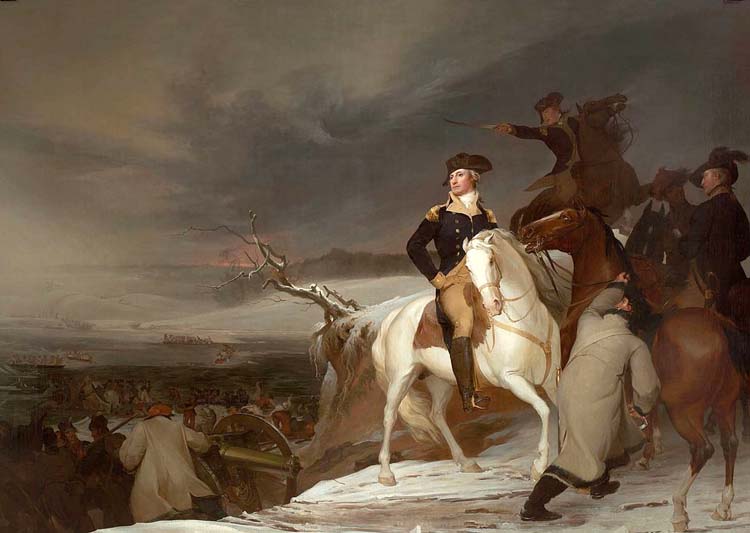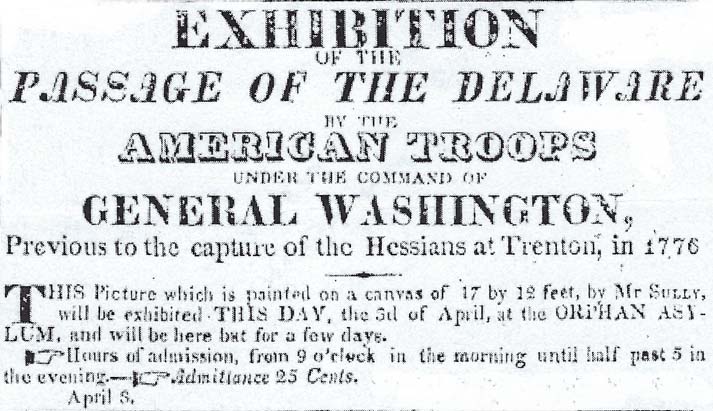Historical Reminiscing with Robert B.
Hitchings
Copyright.
All rights reserved.

1819 Passage Of The Delaware by Thomas Sully MFA Boston
A few days ago I had my eyes in the 1820 Norfolk & Portsmouth Hearld newspapers, one of Norfolk’s oldest newspapers. By accident my eyes caught an ad about an unusual painting, The Passage of the Delaware, by Thomas Sully (1783-1872), circulating up and down our East Coast. Frankly speaking, I was captivated by the ad, since I had never heard of this famous painting. However, I knew of the famous painting, Washington Crossing the Delaware.
Apparently, The Passage of the Delaware was the forerunner of Emanuel Leutze’s 1851 famous painting we all know today as Washington Crossing the Delaware.
According to the ad, this painting was exhibited up and down the East coast in April 1820. The painting was exhibited the first week of April 1820 here at the Norfolk’s Orphan Asylum, which to me is an unusual place to have an exhibit. Apparently, this Orphan Asylum building had large rooms to accommodate this unusual large painting and the people.
The measuments of this painting were twelve feet tall by seventeen feet wide. This painting which Thomas Sully called “A Historical Portrait,” was commissioned by the state of North Carolina, but was too large for their state building.
Do to the enormous size of this painting, North Caroline commissioners rescinded and the painting was bought by a John Doggett for $500.00. John Doggett sold the painting to Ethan Allen Greenwood for his New England Museum in Boston. In 1839, Ethan Allan Greenwood sold the painting to Moses Kimball who donated it to the Boston Museum and Gallery of Fine Arts in 1903. Today, in this museum we can see this magnificent painting. The painting still has its original frame crafted by a local Boston artisan, John Doggett.
Sully’s painting is magnificent, and one quickly notices his brush strokes and gestures of the figures in the painting, especially Gen. George Washington’s face. It was painted with an expression that only Sully envisioned him in having. The group of men in the painting includes William Lee, an African American slave valet to George Washington. In the painting we can see the Continental Army crossing the icy Delaware River in the night with 2,400 men, horses and eighteen cannons. Looking at the painting, many of Washington’s soldiers looked half-starved, and due to the extreme cold, many had to wrap their feet in bandages, not having proper boots. One can see and imanage the hardship Washington and his troops endured that night; but despite the cold winter, General Washington’s Continental Army took on the Hessian garrison in Trenton by surprise and won the battle. The year was 1776. It was a much needed victory for Washington. In my opinion, this painting by Sully is very accurate of the hardships Washington and his troops endured during that winter. This rag-tag army of Washington’s took on the most formidable Army force in the world, and that was the British Army.
For some unknown reason Thomas Sully did not care for this painting. No one really knows for sure why, but some think it was due to individuals making thousands of extra dollars touring the United States. He only received a commission of $500.00.
Thomas Sully had a Norfolk connection, although he was born in Horn Castle, Lincolnshire, on June 19, 1783, and died in Philadelphia, Pennsylvania, November 5, 1872. He was an American painter of English birth. Sully came to America in 1792 with his family who were theatre and circus performers. They landed in Norfolk, Virginia, in early July 1792 with 11 members of his family. They had 6 weeks at sea. They had come to America to join a Virginia Company of Comedians. Thomas Sully made one appearance on stage as an acrobat in 1794. He was only 11 years old. Later, he was placed as an apprentice under an insurance broker. Showing a talent for drawing, he was quickly placed with his brother-in-law Jean Belzons, who was a miniature painter. He excelled in his painting under Jean Belzon.
In April 1802, he opened up his first studio which was here in Norfolk, Virginia, on Dameron’s Lane. He later married his sister-in-law, Sarah Annis Sully, widow of his brother Lawrence Sully, quickly assuming responsibility of her three children. Soon he would move to Philadelphia and open up a studio, but also embarked for England to study painting under Benjamin West and Thomas Lawrence, well- known English painters.
It is interesting to note, there are two Thomas Sully portraits in the historical Moses Myers Hosue collection, Norfolk, Virginia, that he painted: John Myers son of Moses Myers and George Frederick Cook. Both are fine portraits hanging in their dining room.
Whether this painting, The Passage of the Delaware by Thomas Sully, was a success here in the Borough of Norfolk, we do not know. But it was the newspaper ad and Sully’s painting that quickly reminded the in habitants of our area to think back on their proud American heritage, a reminder how far we had come as a nation and the sacrifices these men and women paid during the Battle of Trenton.
Looking back on this exhibit of April 1820, maybe a traveling exhibit of these fine paintings would remind our citizens of our history, the American Revolution and other victories that many Americans know so little about now. Today we live in this free and independent nation we call America. This display of our heritage in paintings could be a reminder who we are and how we broke the ties with England during the American Revolution.
* * * * * *
Robert B. Hitchings is a seventh generation Norfolk resident, graduating with an Associate's Degree in Biology from Old Dominion University and BA in history from Virginia Wesleyan University. During his studies he was awarded a scholarship at Emmanuel College, Cambridge, England, and he was an exchange student at Brooks-Westminster College, Oxford, England. From 1999-2014 he worked as head of the Sargeant Memorial History Room at Norfolk Public Library, and since then has headed the Wallace History Room at Chesapeake Public Library. He is also the President of the Norfolk County Historical Society, and for six years was a columnist for The Virginian-Pilot. Robert may be reached at nchs.wallaceroom@gmail.com

